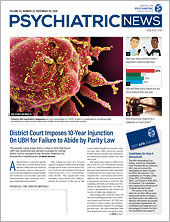As part of its ever-expanding inventory of digital resources, APA’s SMI Adviser has released a new mobile app that will enable individuals with serious mental illness (SMI) to plan out and share their treatment desires in advance of a mental health crisis. Known as My Mental Health Crisis Plan, this is SMI Adviser’s first patient-focused mobile application.
My Mental Health Crisis Plan provides users with a step-by-step guide on how to create a psychiatric advance directive (PAD). A PAD is a legal document of a patient’s wishes in the event he or she is unable to make decisions due to worsening illness.
PADs contain information such as a patient’s preferences for medication or hospitals, the name of the patient’s health care agent (who can make decisions on behalf of the patient), and other parties who should be notified in a crisis (such as the patient’s psychiatrist).
Once completed, the PAD can be instantly sent as a PDF via email or scanned through a QR code, said Tristan Gorrindo, M.D., director of education for APA and the director of SMI Adviser.
“We wanted to ensure these directives don’t live in the confines of one phone and that even people without a device can create one,” he said.
My Mental Health Crisis Plan was developed following the release of a PAD toolkit in 2019 from the Substance Abuse and Mental Health Services Administration (SAMHSA) to educate physicians about the benefits of PADs and how to discuss them with patients. SMI Adviser is funded by SAMHSA.
“In conjunction with SAMHSA’s clinician-geared toolkit, we thought an app that could reduce patient barriers to establishing a PAD would be valuable,” said Gorrindo.
One such barrier can be state requirements to certify the document. The new app includes all the state-specific requirements to certify a PAD, which range from just approving the document with a phone’s fingerprint ID to printing out a hard copy and having it notarized.
“But even if patients do not go so far as to make their document legally enforceable, the app still empowers them to take control of their illness,” Gorrindo explained. “Patients think about what’s important to them, and they are prompted to have conversations about their illness with people they trust. It’s why we called the app My Mental Health Crisis Plan and not My Advanced Directive Plan.”
Marvin Swartz, M.D., a professor of psychiatry and behavioral sciences at Duke University who served as a consultant for the My Mental Health Crisis Plan app and SAMHSA’s PAD toolkit, said this app provides a needed tool to help PADs reach their potential.
Numerous studies over the past 20 years have shown PADs can reduce the need for crisis interventions or involuntary hospitalizations, yet they are still not being routinely used in clinical practice, he said. A 2006 study Swartz co-authored assessed over 1,000 patients with SMI and found that only 5% had a PAD. When asked, two-thirds of these patients said they would create a PAD if they received assistance with it.
While some physicians may worry that discussing the possibility of a psychiatric crisis with a patient can be stigmatizing, Swartz said that the available evidence shows this not to be the case.
“[D]iscussions about what to do in a crisis enhance the treatment alliance,” he told Psychiatric News. Swartz noted that when collecting information for the 2006 study, “[p]atients would say things like, ‘No one ever asked me what has gone well or poorly in a previous crisis, and [the discussion] made me feel closer to my provider.’ ”
He added that encouraging greater use of PADs may also help to ensure equal treatment of all patients regardless of their race. “People in a crisis cannot speak for themselves, and if a voice cannot be found quickly, the default is involuntary commitment,” he said. “The data show large racial disparities in terms of which patients become committed. An easy-to-access tool like this app can [help] level the playing field.” ■
More information about My Mental Health Crisis Plan is posted
here.
SAMHSA’s “Practical Guide to Psychiatric Advance Directives” is posted
here.

